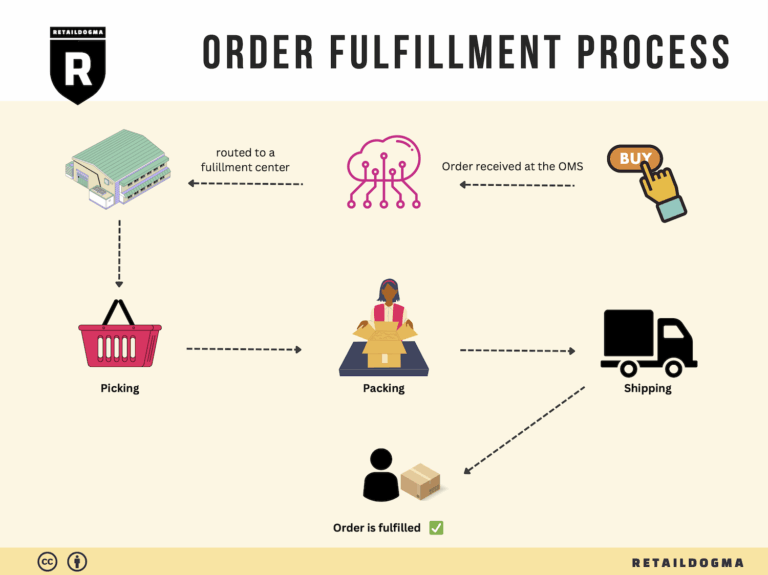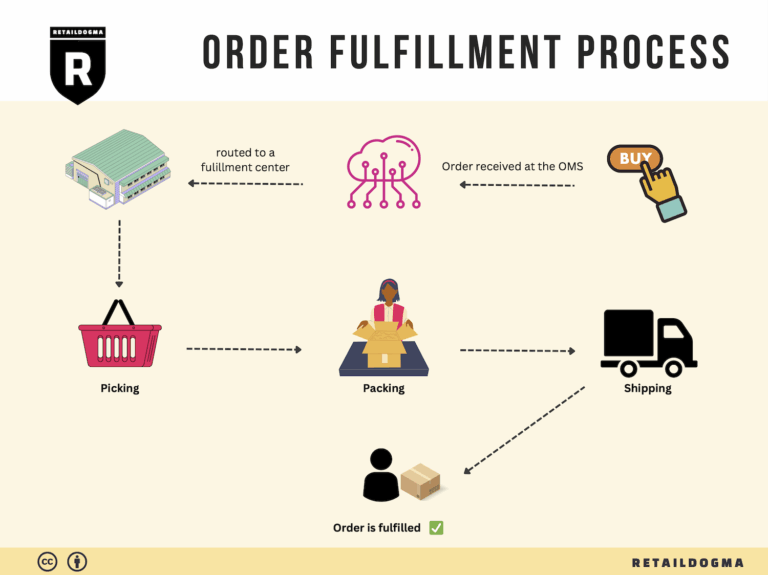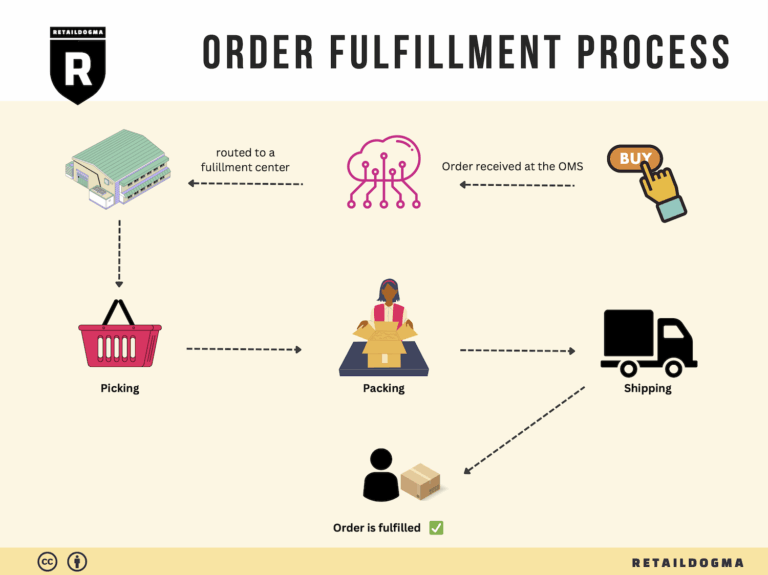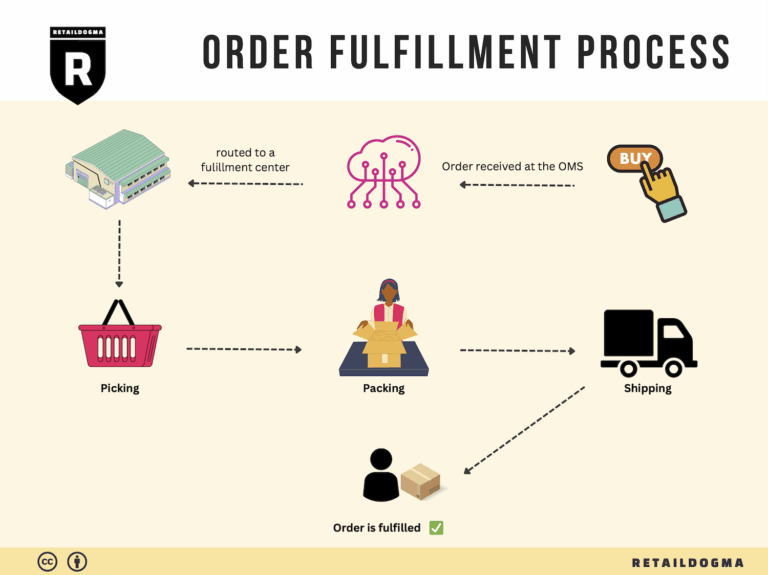How Order Fulfillment Works: A Step-by-Step Guide for Businesses
What is E-commerce Fulfillment? An Introduction for Growing Businesses
Understanding E-commerce Fulfillment: A Key to Scaling Your Business
As your online business begins to grow, the excitement of increasing sales can quickly be overshadowed by the daunting tasks of packing and shipping orders. Many entrepreneurs find themselves overwhelmed by the logistical challenges of fulfilling customer demands while trying to maintain quality and efficiency. This is where e-commerce fulfillment comes into play.
E-commerce fulfillment is essentially the process of getting a product from your inventory to your customer’s doorstep. It encompasses everything from receiving orders, picking and packing items, shipping them, and handling returns. As your business scales, understanding the intricacies of fulfillment becomes crucial for maintaining customer satisfaction and operational efficiency.
In this guide, we will explore various fulfillment models that can help streamline your logistics. You will learn about third-party logistics (3PL) providers, which offer comprehensive services to manage your inventory and shipping needs, and Fulfillment by Amazon (FBA), a popular choice for sellers on the Amazon platform. Each model has its own advantages and considerations, making it essential to choose one that aligns with your business goals.
We will also delve into the core services involved in e-commerce fulfillment, including inventory management, order processing, and customer service. Understanding these components will help you identify the specific needs of your business and how fulfillment partners can meet them.
Selecting the right fulfillment partner is another critical aspect that this guide will cover. Factors such as cost, service quality, technology integration, and scalability should all be considered to ensure that your chosen partner can grow alongside your business.
Finally, we will break down pricing structures associated with different fulfillment options. From storage fees to shipping costs and service charges, understanding these expenses will empower you to make informed financial decisions.
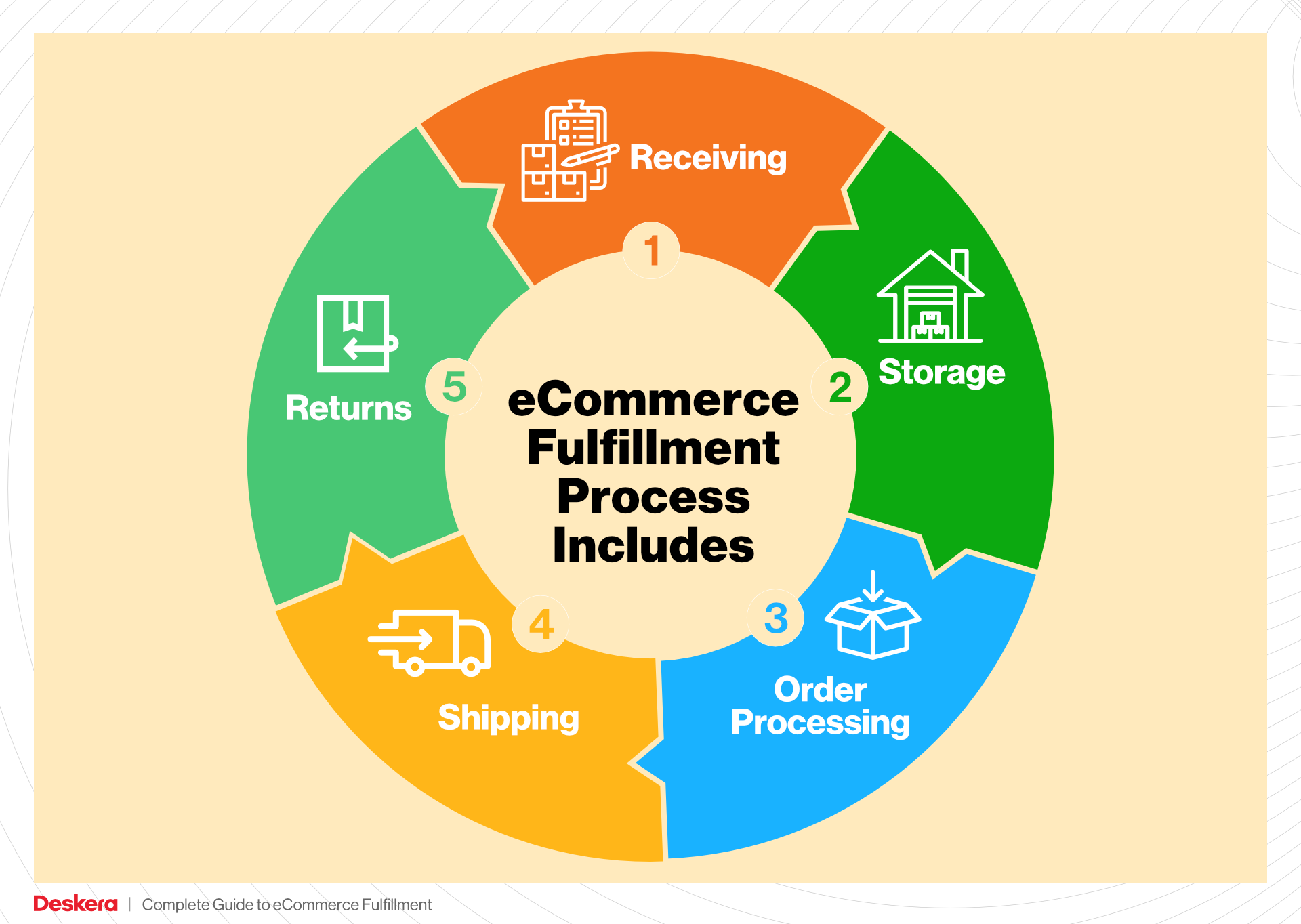
The goal of this guide is to equip you with the knowledge necessary to navigate the complexities of e-commerce fulfillment. By understanding your options and how to choose the right partners, you can streamline your logistics, enhance customer satisfaction, and ultimately scale your business with confidence.
What You’ll Learn In This Guide
- What is E-commerce Fulfillment? An Introduction for Growing Businesses
- The Order Fulfillment Process: From ‘Buy’ Button to Customer’s Door
- Comparing Fulfillment Models: In-House vs. 3PL vs. Dropshipping
- A Deep Dive into Amazon FBA: Pros, Cons, and Who It’s For
- Core Services Offered by Fulfillment Centers
- How to Choose a Fulfillment Partner: A 6-Point Checklist
- Understanding Fulfillment Pricing: A Breakdown of Common Fees
- Frequently Asked Questions (FAQs) about Fulfillment
- Conclusion: Is Outsourcing Fulfillment the Right Move for Your Business?
- Important Disclaimer
The Order Fulfillment Process: From ‘Buy’ Button to Customer’s Door
1. Receiving Inventory
The first step in the order fulfillment process is receiving inventory at the fulfillment center. This involves accepting shipments from suppliers, verifying the quantity and quality of the items against purchase orders, and recording them into the inventory management system.
This step is crucial because accurate receiving ensures that the inventory levels are correct, which directly impacts order fulfillment accuracy and inventory management. A key term associated with this step is SKU (Stock Keeping Unit), which is a unique identifier for each product. By using SKUs, businesses can efficiently track inventory and facilitate faster processing in subsequent steps.
2. Warehouse Storage
Once the inventory is received and verified, it is then stored in the fulfillment center. Effective warehouse storage involves organizing products in a manner that optimizes space and facilitates quick access. Items are often categorized based on size, weight, and demand frequency, which helps in streamlining the picking process later on.
This step is important because poorly organized storage can lead to delays in order fulfillment and increased labor costs. A key term here is ABC analysis, a method used to categorize inventory into three classes (A, B, and C) based on their importance. Class A items are high-value products that require tight inventory control, while Class C items are less critical and can be managed with looser controls.
3. Order Picking
The next step is order picking, where items are retrieved from storage to fulfill customer orders. Fulfillment centers use various methods for picking, such as batch picking (picking multiple orders simultaneously) or wave picking (picking items for several orders at once based on specific criteria).
Order picking is a pivotal phase because it directly affects the speed and accuracy of order fulfillment. Errors in this step can lead to customer dissatisfaction and increased returns. A critical tool in this process is the pick list, which is a document or digital display that outlines the items and quantities required for each order. Utilizing pick lists helps workers focus on the correct items, minimizing mistakes.
4. Order Packing
After items have been picked, they move to the packing station, where they are prepared for shipment. This involves checking the items against the order to ensure accuracy, packaging them securely, and labeling the packages with shipping information.
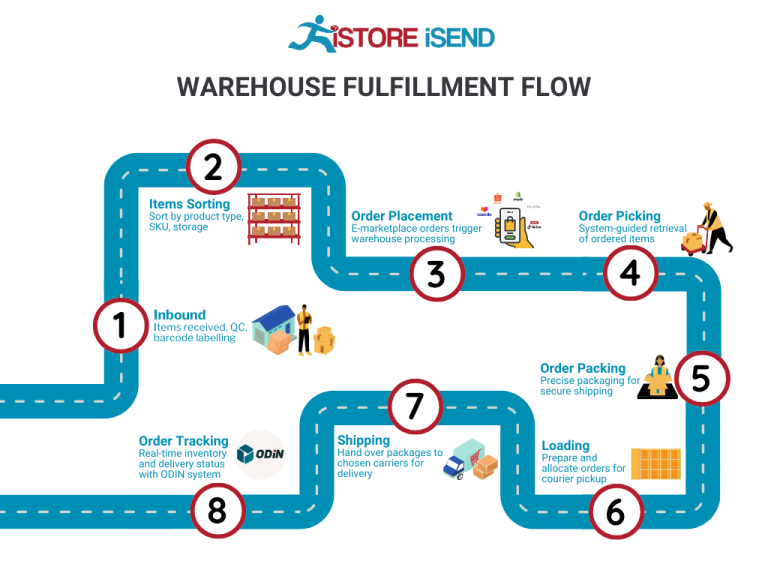
The packing step is essential for protecting products during transit and ensuring that they reach customers in perfect condition. Additionally, efficient packing contributes to cost savings in shipping. A key term related to this stage is packaging optimization, which refers to selecting the right materials and dimensions for packaging to minimize shipping costs while ensuring product safety.
5. Shipping & Delivery
The final step in the order fulfillment process is shipping and delivery. Once the orders are packed, they are handed over to shipping carriers for delivery to customers. This stage includes choosing the most cost-effective and timely shipping options, tracking packages, and managing returns or exchanges.
Shipping and delivery are critical as they represent the last interaction between the business and the customer. Timely and reliable delivery can significantly enhance customer satisfaction and loyalty. A key term in this phase is last-mile delivery, which refers to the final leg of the shipping process where the package is delivered from a distribution center to the customer’s doorstep. Effective last-mile strategies can reduce shipping costs and improve delivery speed, which is increasingly important in today’s e-commerce landscape.
By understanding and optimizing each of these five steps in the order fulfillment process, e-commerce businesses can enhance their operational efficiency, reduce costs, and ultimately improve customer satisfaction.
Comparing Fulfillment Models: In-House vs. 3PL vs. Dropshipping
Fulfillment Model Comparison Table
| Model | Who Handles Inventory | Best For (Business Stage) | Key Advantage | Key Disadvantage |
|---|---|---|---|---|
| In-House Fulfillment | Your own team | Established businesses | Complete control over operations | High overhead costs and resource demand |
| Third-Party Logistics (3PL) | Outsourced logistics provider | Growing businesses | Scalability and reduced capital risk | Less control over fulfillment process |
| Dropshipping | Supplier/manufacturer | Startups and small businesses | Low upfront investment and risk | Lower profit margins and reliance on suppliers |
In-House Fulfillment
In-house fulfillment involves managing the entire logistics process within your own facilities. This model is typically utilized by established businesses that have the resources to maintain their own warehousing, staffing, and shipping operations. One of the primary advantages of in-house fulfillment is the level of control it offers; businesses can oversee every aspect of the fulfillment process, ensuring quality and efficiency. This control allows for tailored packaging, personalized customer service, and the ability to respond quickly to issues. However, this model comes with significant drawbacks, including high overhead costs associated with warehousing space, staff salaries, and equipment maintenance. Moreover, managing inventory levels and logistics can divert focus from core business activities, potentially stunting growth.
Third-Party Logistics (3PL)
Third-party logistics providers manage the fulfillment process on behalf of businesses, handling everything from inventory storage to shipping. This model is ideal for growing businesses that want to scale operations without the financial burden of maintaining their own fulfillment centers. The key advantage of using a 3PL is scalability; businesses can adjust their logistics needs based on fluctuating demand without investing in additional infrastructure. Additionally, 3PLs often have established relationships with shipping carriers, leading to reduced shipping costs and faster delivery times. However, the trade-off is a loss of direct control over fulfillment processes. If a 3PL fails to meet service expectations, it can negatively impact customer satisfaction. Businesses must also ensure they choose a reliable 3PL partner to mitigate risks associated with inventory management and fulfillment accuracy.
Dropshipping
Dropshipping is a fulfillment model where businesses sell products without holding any inventory. Instead, when a customer places an order, the business purchases the item from a third-party supplier, who then ships it directly to the customer. This model is particularly advantageous for startups and small businesses, as it requires minimal upfront investment and allows for a broad product range without the need for warehousing. The low financial risk associated with dropshipping makes it an attractive option for entrepreneurs testing new markets or products. However, dropshipping presents several challenges, such as lower profit margins due to reliance on suppliers and potential delays in shipping that can affect customer satisfaction. Additionally, businesses must depend on their suppliers for product quality and inventory management, which can lead to complications if the supplier fails to deliver as promised.
Conclusion
Choosing the right fulfillment model is crucial for e-commerce businesses looking to scale. In-house fulfillment offers complete control but at a higher cost, making it suitable for established businesses. Third-party logistics provide scalability and efficiency, ideal for growing companies, albeit with reduced control. On the other hand, dropshipping presents a low-risk entry point for startups, but comes with challenges that can affect profitability and customer satisfaction. Each model has its strengths and weaknesses, and the best choice depends on the specific needs and stage of your business.
A Deep Dive into Amazon FBA: Pros, Cons, and Who It’s For
Understanding Fulfillment by Amazon (FBA)
Fulfillment by Amazon (FBA) is a service offered by Amazon that allows sellers to store their products in Amazon’s fulfillment centers. With FBA, Amazon takes care of storage, packaging, and shipping of products directly to customers. This service not only streamlines the logistics process for sellers but also enables them to leverage Amazon’s vast distribution network and customer service capabilities.
How FBA Works
-
Account Setup: Sellers need to create an Amazon seller account. They can choose between an Individual or Professional account, with the latter being more suitable for those planning to sell in volume.
-
Product Listing: Once the account is set up, sellers list their products on Amazon, specifying that they will be using FBA.
-
Shipping Inventory: Sellers prepare their products and ship them to Amazon’s fulfillment centers. It’s crucial to follow Amazon’s guidelines for labeling and packaging to avoid complications.
-
Storage: After receiving the inventory, Amazon stores the products in their warehouses. Sellers are charged monthly storage fees based on the volume of inventory stored.
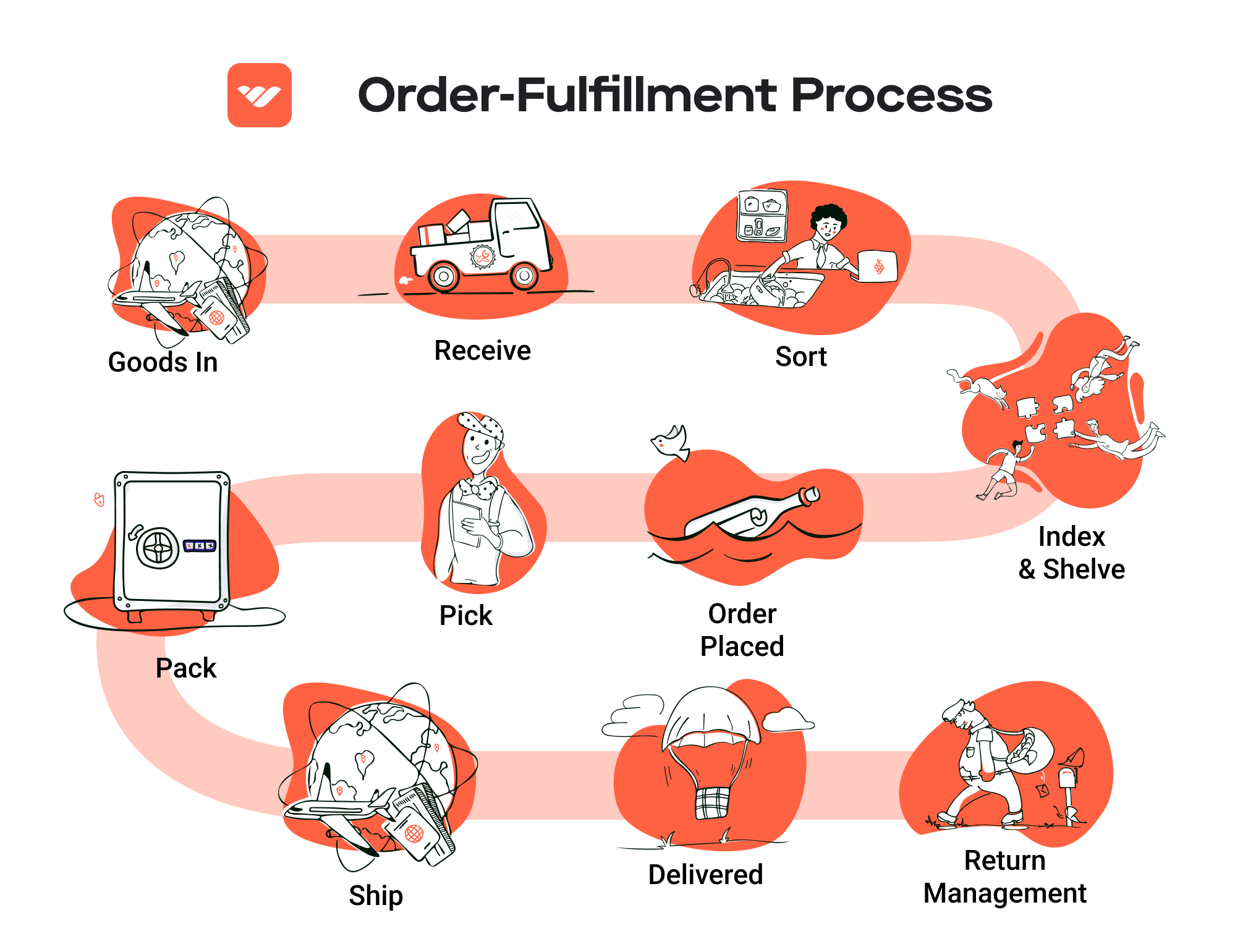
-
Order Processing: When a customer places an order for a product, Amazon handles the picking, packing, and shipping. They also manage customer service and returns.
-
Fees: Sellers incur various fees, including FBA fulfillment fees (based on product size and weight) and storage fees, which can vary depending on the time of year and inventory turnover.
Pros of Using FBA
-
Prime Eligibility: Products fulfilled through FBA are eligible for Amazon Prime, which can significantly increase visibility and sales. Prime members often prefer products with the Prime badge due to the promise of fast and free shipping.
-
Customer Trust: Selling through Amazon enhances credibility. Customers trust Amazon’s customer service and return policies, which can lead to higher conversion rates for FBA sellers.
-
Multi-Channel Fulfillment: FBA can be used to fulfill orders from other sales channels, such as eBay or your own website. This flexibility allows businesses to streamline operations and manage inventory more effectively.
-
Time Savings: By outsourcing logistics to Amazon, sellers can focus on other aspects of their business, such as marketing and product development. This can be particularly beneficial for small businesses or solo entrepreneurs.
-
Scalability: FBA provides a scalable solution for growing businesses. As demand increases, sellers can easily send more inventory to Amazon without the need to invest in additional warehouse space.
Cons of Using FBA
-
High Fees: FBA fees can add up quickly, including fulfillment fees (which vary by product size and weight) and monthly storage fees. Sellers must carefully calculate their costs to ensure profitability.
-
Strict Inventory Rules: Amazon has strict policies regarding inventory management, including limits on how much inventory can be sent to their warehouses. Sellers must manage their stock levels proactively to avoid penalties.
-
Commingling Risks: FBA utilizes a commingling model, meaning that products from different sellers may be stored together. This can lead to risks such as receiving returns that do not belong to the seller or dealing with counterfeit issues.
-
Loss of Control: When using FBA, sellers relinquish a certain level of control over their inventory and shipping processes. This can be a concern for those who prefer to manage these aspects directly.
-
Long-Term Storage Fees: Products that sit in Amazon’s warehouses for an extended period incur additional long-term storage fees. Sellers must manage their inventory turnover to avoid these extra costs.
Who is FBA Best For?
Fulfillment by Amazon is particularly beneficial for sellers who:
-
Have a Product with High Demand: Businesses with fast-moving products can take advantage of FBA’s logistics and Prime eligibility to boost sales.
-
Lack Infrastructure: Smaller businesses or startups without the resources to manage warehousing and shipping can benefit from outsourcing these tasks to Amazon.
-
Plan to Scale: Sellers looking to grow their business rapidly can use FBA to handle increased order volumes without the need for significant upfront investments in logistics.
-
Sell Across Multiple Channels: Businesses that sell on various platforms can use FBA to centralize their fulfillment process, simplifying inventory management.
-
Prioritize Customer Experience: Sellers who want to enhance their customer service through Amazon’s established policies and procedures will find FBA appealing.
In conclusion, while Fulfillment by Amazon offers numerous advantages, including increased visibility and time savings, potential sellers must carefully weigh the costs and risks involved. By understanding the dynamics of FBA, e-commerce business owners can make informed decisions that align with their growth strategies and operational capabilities.
Core Services Offered by Fulfillment Centers
Inventory Management & Warehousing
Fulfillment centers provide comprehensive inventory management and warehousing services, which are crucial for e-commerce businesses looking to scale. This service involves the storage of products in a secure facility, along with systems to monitor stock levels, manage reorders, and forecast inventory needs.
Benefits:
1. Efficiency in Operations: By outsourcing warehousing, businesses can reduce overhead costs associated with maintaining their own storage facilities. Fulfillment centers leverage advanced inventory management software that allows for real-time tracking of stock levels, ensuring that businesses have the right amount of inventory on hand to meet customer demand without overstocking.
-
Scalability: As e-commerce businesses grow, their inventory needs can change rapidly. Fulfillment centers offer flexible warehousing solutions that can scale up or down based on seasonal demand or business growth, allowing businesses to adapt quickly without the financial burden of long-term leases or additional staffing.
-
Reduced Risk of Stockouts: With sophisticated inventory management systems, fulfillment centers can alert businesses when stock is running low, enabling timely reorders and minimizing the risk of stockouts, which can lead to lost sales and dissatisfied customers.
Pick and Pack Services
Pick and pack services are a core offering of fulfillment centers, involving the process of selecting ordered items from inventory, packing them securely, and preparing them for shipment. This service is essential for ensuring that orders are fulfilled accurately and efficiently.
Benefits:
1. Accuracy and Speed: Fulfillment centers are equipped with specialized technology and trained staff that can quickly and accurately pick items for orders. This speed is crucial for meeting customer expectations for fast shipping, especially during peak shopping seasons.
-
Quality Control: Fulfillment centers often implement quality control measures during the pick and pack process, reducing the likelihood of shipping errors. By ensuring that the correct items are packed and sent to customers, businesses can enhance customer satisfaction and reduce the costs associated with returns and refunds.
-
Custom Packaging Options: Many fulfillment centers offer customizable packaging solutions that can help businesses create a unique brand experience. This can include branded boxes, packing slips, and promotional materials, which can enhance customer loyalty and repeat business.
Kitting and Assembly
Kitting and assembly services involve the process of combining multiple products into a single, ready-to-ship package. This is particularly beneficial for businesses that sell products that are often bundled together or require assembly before shipping.
Benefits:
1. Streamlined Operations: By outsourcing kitting and assembly, businesses can save time and resources. Fulfillment centers can handle complex assembly tasks, allowing e-commerce businesses to focus on core activities such as marketing and sales.
-
Enhanced Product Offerings: Kitting allows businesses to create unique product bundles or promotional packages that can attract customers. This can lead to increased average order values and improved sales during promotional campaigns.
-
Reduced Shipping Costs: By combining products into a single package, businesses can often reduce shipping costs. This not only saves money but can also improve the overall customer experience by providing a single, consolidated shipment rather than multiple packages.
Returns Management (Reverse Logistics)
Returns management, or reverse logistics, is a critical service offered by fulfillment centers that involves the handling of returned products. Efficient returns management is essential for maintaining customer satisfaction and loyalty.
Benefits:
1. Streamlined Returns Process: Fulfillment centers can manage the entire returns process, from receiving returned items to inspecting and restocking them. This ensures that returns are processed quickly and efficiently, minimizing the impact on inventory levels and cash flow.
-
Data Insights: Fulfillment centers often provide detailed reporting on return reasons and trends. This data can help businesses identify potential issues with products or customer satisfaction, enabling them to make informed decisions to improve product offerings and reduce return rates.
-
Customer Satisfaction: A smooth returns process is crucial for customer retention. By offering hassle-free returns through a fulfillment center, businesses can enhance the overall shopping experience, encouraging repeat purchases and fostering customer loyalty.
In conclusion, the core services offered by fulfillment centers—inventory management and warehousing, pick and pack services, kitting and assembly, and returns management—are integral to the success of e-commerce businesses. By leveraging these services, businesses can enhance operational efficiency, improve customer satisfaction, and ultimately scale their operations effectively.
How to Choose a Fulfillment Partner: A 6-Point Checklist
Location & Warehouse Network
Importance: The geographic location of your fulfillment partner’s warehouses can significantly impact your shipping costs and delivery times. A partner with a strategically located network can help reduce transit times and improve customer satisfaction.
Questions to Ask:
– Where are your fulfillment centers located, and how do they align with my target market?
– Do you have a network of warehouses that can facilitate faster shipping options?
– How do you manage inventory across multiple locations, and can you provide real-time updates?
Technology & Integrations
Importance: The technology used by your fulfillment partner plays a critical role in ensuring smooth operations. Efficient systems can streamline order processing, inventory management, and shipping logistics, allowing for seamless integration with your existing e-commerce platforms.
Questions to Ask:
– What fulfillment software do you use, and how does it integrate with my e-commerce platform (e.g., Shopify, Amazon)?
– Can you provide API access for real-time inventory tracking and order management?
– How do you handle order processing during peak seasons, and what technology supports this?
Specializations (e.g., Cold Storage, Oversized Items)
Importance: Depending on the nature of your products, you may require specialized storage or handling capabilities. A fulfillment partner that can accommodate specific needs (like temperature control for perishables or extra space for bulky items) is essential for maintaining product integrity.
Questions to Ask:
– Do you have the capability to handle specialized products, such as cold storage or oversized items?
– What certifications or compliance measures do you have in place for handling sensitive products?
– Can you provide case studies or examples of how you’ve successfully managed specialized inventory?
Scalability & Capacity
Importance: As your business grows, your fulfillment partner must be able to scale operations accordingly. This includes not only increasing capacity for inventory but also adapting to changing order volumes without compromising service quality.
Questions to Ask:
– How do you handle peak seasons or sudden spikes in order volume?
– What is your current capacity, and how easily can you scale up to meet my needs?
– Can you provide information on your past performance during peak periods?
Pricing and Contracts
Importance: Understanding the pricing structure and contract terms of a fulfillment partner is crucial for budgeting and financial forecasting. Hidden fees can quickly erode margins, so clarity in pricing is essential.
Questions to Ask:
– Can you provide a detailed breakdown of your pricing structure, including any hidden fees (e.g., storage, handling, shipping)?
– What are the terms of your contracts, and is there flexibility for renegotiation based on performance?
– Do you offer volume discounts or tiered pricing based on order frequency?
Customer Support & Reviews
Importance: Strong customer support can make a significant difference in your operational efficiency and the overall experience of your customers. A responsive partner can address issues quickly and help maintain a high level of service.
Questions to Ask:
– What kind of customer support do you offer, and what are your response times?
– Can you provide references or testimonials from current clients regarding your support services?
– How do you handle disputes or issues that arise during the fulfillment process?
Conclusion
Choosing the right fulfillment partner is a critical decision that can impact your e-commerce business’s efficiency and customer satisfaction. By carefully evaluating potential partners using this checklist, you can ensure that you select a fulfillment solution that aligns with your business goals and growth trajectory. Prioritize partners who demonstrate transparency, adaptability, and a commitment to service excellence to set your business up for success.
Understanding Fulfillment Pricing: A Breakdown of Common Fees
Initial Setup Fees
When entering the world of fulfillment services, businesses often encounter initial setup fees. These charges can vary significantly depending on the fulfillment center and the specific requirements of your business. Initial setup fees typically cover the costs associated with onboarding your products into the system, which may include:
- Account Setup: Creating your account in the fulfillment system.
- Product Listing: Adding your products to the inventory management system, which may include barcoding and SKU creation.
- Integration Costs: Setting up integrations with your e-commerce platform (like Shopify or WooCommerce) or any necessary software tools.
These fees can range from a few hundred to several thousand dollars, depending on the complexity of your inventory and the fulfillment provider’s capabilities. It’s essential to clarify what is included in these fees to avoid unexpected costs later.
Receiving Fees
Receiving fees are charged when your inventory arrives at the fulfillment center. These fees cover the labor and resources required to unload, inspect, and store your products.
Calculating receiving fees generally involves:
- Per Unit Cost: A fee for each item received, which can be influenced by the size and weight of the products. For instance, heavier or bulkier items may incur higher fees.
- Handling Fees: Additional charges may apply if the goods require special handling, such as fragile items or those needing specific temperature controls.
Understanding the receiving fee structure is crucial, as it can significantly impact your overall fulfillment costs, especially if you plan to send large shipments.
Storage Fees (per pallet/bin)
Once your products are in the fulfillment center, you will incur storage fees based on the space your inventory occupies. These fees are typically calculated on a monthly basis and can vary based on the type of storage used:
- Monthly Storage Fees: Charged per pallet or bin, depending on the fulfillment center’s pricing model. For example, if you rent a pallet space that can hold 1,000 lbs, your fee might be based on how many pallets you utilize during the month.
- Long-Term Storage Fees: In addition to monthly fees, many fulfillment centers charge extra for items that remain in storage for an extended period, usually over six months. This is a deterrent against holding excess inventory.
To manage these costs effectively, businesses should regularly review their inventory levels and implement strategies to minimize long-term storage.
Pick & Pack Fees (per item/order)
Pick and pack fees are incurred every time an order is processed. This fee structure is critical as it directly affects the cost of fulfilling customer orders. The fees are generally calculated as follows:
- Per Item Fee: A fee is charged for each item picked from inventory. This can vary based on the size and weight of the items.
- Order Processing Fee: This may include a flat fee for picking and packing an entire order, which can also consider the complexity of the order (e.g., multiple items in one shipment).
Understanding how pick and pack fees work is vital for forecasting your fulfillment costs accurately. Businesses can negotiate bulk rates if they have a high order volume.
Shipping Fees
Shipping fees are one of the most variable components of fulfillment pricing and can significantly impact your overall costs. These fees depend on several factors:
- Destination: Shipping costs vary based on the distance from the fulfillment center to the customer’s location.
- Shipping Method: Different shipping options (standard, expedited, or same-day) come with varying costs. Choosing the right shipping method can balance customer satisfaction with your budget.
- Weight and Dimensions: Carriers often calculate shipping costs based on the weight and size of the package. Heavier or oversized items will incur higher fees.
To manage shipping costs effectively, businesses should compare carrier rates, consider using flat-rate shipping options, and leverage volume discounts when possible.
Tips for Getting an Accurate Quote
- Provide Detailed Information: When requesting quotes, provide comprehensive details about your inventory, including dimensions, weights, and expected order volumes.
- Ask About Hidden Fees: Inquire about any additional fees that may not be included in the initial quote, such as seasonal surcharges or penalties for long-term storage.
- Compare Multiple Providers: Don’t settle for the first quote. Compare offers from different fulfillment centers to find the best value for your business.
- Negotiate Terms: If you anticipate high order volumes, don’t hesitate to negotiate terms. Many fulfillment centers are willing to adjust pricing for larger clients.
- Review Regularly: As your business scales, regularly review your fulfillment costs and services. Adjust your strategy based on inventory turnover and shipping patterns to optimize expenses.
By understanding these common fulfillment pricing models and actively managing your costs, you can enhance your operational efficiency and improve your bottom line as you scale your e-commerce business.
Frequently Asked Questions (FAQs) about Fulfillment
1. What are FBA fulfillment fees?
FBA fulfillment fees are charges incurred by sellers using Amazon’s Fulfillment by Amazon (FBA) service. These fees cover the costs of picking, packing, and shipping products from Amazon’s warehouses to customers. The fees are determined by the size and weight of the products and are deducted from the seller’s account after a sale is made.
2. How are FBA fulfillment fees calculated?
FBA fulfillment fees are primarily based on two factors: the size and weight of your products. Amazon categorizes items into standard size and oversized categories, each with specific fee structures. As of February 2024, Amazon will implement more granular rate cards, allowing for more precise fee calculations.
3. What are the different types of FBA fees?
There are several types of fees associated with FBA, including:
– Fulfillment fees: Charged for picking, packing, and shipping your products.
– Storage fees: Charged for storing your products in Amazon’s fulfillment centers, which can be monthly or long-term based on the duration of storage.
– Referral fees: A commission paid to Amazon for each sale, typically a percentage of the sale price.
4. What is the difference between a warehouse and a fulfillment center?
A warehouse is primarily a storage facility where goods are kept until needed. In contrast, a fulfillment center is designed specifically for order processing, which includes picking, packing, and shipping products directly to customers. Fulfillment centers often have advanced technology and systems in place to ensure quick and accurate order fulfillment.
5. What is a 3PL (Third-Party Logistics)?
A 3PL refers to an external service provider that manages logistics and supply chain operations for businesses. This can include warehousing, fulfillment, shipping, and inventory management. Using a 3PL can help e-commerce businesses scale operations without the overhead of maintaining their own facilities.
6. How much do fulfillment services cost?
The cost of fulfillment services varies widely based on the provider and the specific services offered. Factors influencing cost include the size and weight of products, storage duration, order volume, and additional services such as packaging and returns handling. It’s essential to compare different providers to find a solution that fits your business needs and budget.
7. Are there any additional fees associated with FBA?
Yes, besides the standard fulfillment and storage fees, there are additional fees that may apply, such as:
– Long-term storage fees: Charged for inventory stored for over 365 days.
– Removal and disposal fees: Charged when you request to remove or dispose of your inventory.
– Refund administration fees: Applicable if a customer returns a product and a refund is issued.
8. How can I reduce my FBA fulfillment fees?
To minimize FBA fees, consider the following strategies:
– Optimize your product size and weight to fall into lower fee tiers.
– Monitor inventory levels to avoid long-term storage fees.
– Use Amazon’s Fee Preview Report to estimate and plan for costs.
– Consider using Amazon’s New Selection program, which may offer reduced fees for qualifying products.
9. What are the peak and off-peak storage fees?
Amazon differentiates between peak and off-peak storage fees based on the time of year. Peak fees typically occur during high-demand periods, such as the holiday season, while off-peak fees apply during the rest of the year. As of April 2024, off-peak monthly storage fees will be reduced for standard-size products.
10. Can I calculate my FBA fees before selling?
Yes, Amazon provides tools like the FBA Calculator and Fee Preview Report, which allow sellers to estimate their fees based on product size, weight, and selling price. Utilizing these tools can help you determine profitability and make informed pricing decisions before listing your products.
Conclusion: Is Outsourcing Fulfillment the Right Move for Your Business?
Evaluating the Benefits of Outsourcing Fulfillment
Outsourcing your fulfillment process can be a transformative decision for your e-commerce business. One of the most significant advantages is the time savings it offers. By delegating logistics to a specialized fulfillment partner, you can focus on core business activities such as product development, marketing, and customer engagement. This shift not only enhances productivity but also allows for greater innovation and strategic growth.
Scalability is another critical benefit. As your business grows, so does the complexity of managing inventory, shipping, and returns. Fulfillment services are designed to scale with your business, offering flexible solutions that can accommodate seasonal spikes in demand or rapid growth phases. This adaptability ensures that you can meet customer expectations without the stress of logistical constraints.
Moreover, partnering with a fulfillment expert brings valuable expertise to your operations. These providers have refined systems, technologies, and processes that can lead to improved accuracy, faster shipping times, and enhanced customer satisfaction. Their insights into best practices can also help you navigate challenges more effectively, ultimately driving better business outcomes.
However, it’s essential to choose the right fulfillment partner to support your growth objectives. Conduct thorough research and evaluate potential partners based on their experience, technology, service levels, and cost structure. A misaligned partnership can hinder your progress rather than accelerate it.
To determine if outsourcing fulfillment is the right next step for your business, consider conducting an audit of your current shipping processes. Identify bottlenecks, inefficiencies, and areas where you could leverage external expertise. This analysis can provide clarity on whether a fulfillment partner could enhance your operational capabilities and fuel your growth.
Important Disclaimer
⚠️ Important Disclaimer
The information in this guide is for educational purposes. Fulfillment services, pricing, and platform features change frequently. Always conduct your own due diligence and consult with providers directly before making business decisions.

